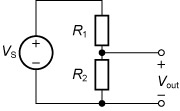3.1 Voltage dividers
Voltage dividers are widely used in electronic circuits to create a reference voltage, or to reduce the amplitude of a signal. Figure 12 shows a voltage divider. The value of can be calculated from the values of , and .
In the first instance, let’s assume that is not connected to anything (for voltage dividers it is always assumed that negligible current flows through ). This means that, according to Kirchhoff’s first law, the current flowing through is the same as the current flowing through . Ohm’s law allows you to calculate the current through . It is the potential difference across that resistor, divided by its resistance. Since the voltage is distributed over two resistors, the potential drop over is .
The current through () is given by
Similarly, the current through is given by
Kirchoff’s first law tells you that , and therefore
Multiplying both sides by and by gives
Then multiplying out the brackets on the right-hand side gives
This can be rearranged to
giving
and therefore the fundamental result is obtained:
SAQ 3
Suppose = 24 V and = 100 Ω. You want = 6 V. What value of do you need?
Answer
Rearranging the equation for gives
and therefore
which means the equation for is
Substituting in the values given,

